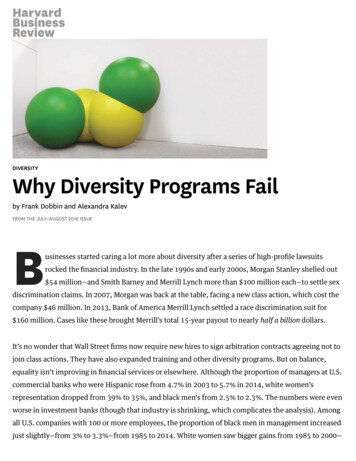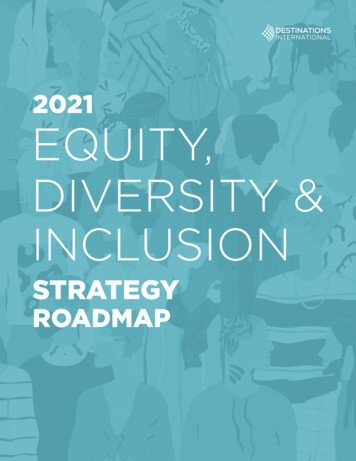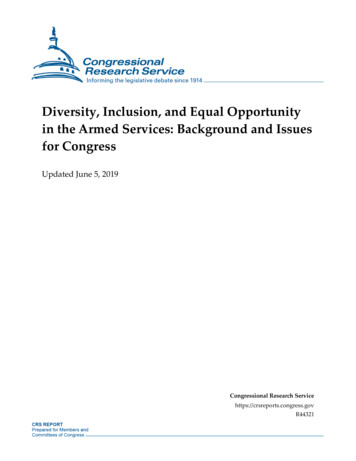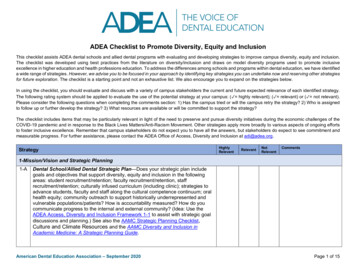
Transcription
DIVERSITYWhy Diversity Programs Failby Frank Dobbin and Alexandra KalevFROM THE JULY–AUGUST 2016 ISSUEBusinesses started caring a lot more about diversity after a series of high-profile lawsuitsrocked the financial industry. In the late 1990s and early 2000s, Morgan Stanley shelled out 54 million—and Smith Barney and Merrill Lynch more than 100 million each—to settle sexdiscrimination claims. In 2007, Morgan was back at the table, facing a new class action, which cost thecompany 46 million. In 2013, Bank of America Merrill Lynch settled a race discrimination suit for 160 million. Cases like these brought Merrill’s total 15-year payout to nearly half a billion dollars.It’s no wonder that Wall Street firms now require new hires to sign arbitration contracts agreeing not tojoin class actions. They have also expanded training and other diversity programs. But on balance,equality isn’t improving in financial services or elsewhere. Although the proportion of managers at U.S.commercial banks who were Hispanic rose from 4.7% in 2003 to 5.7% in 2014, white women’srepresentation dropped from 39% to 35%, and black men’s from 2.5% to 2.3%. The numbers were evenworse in investment banks (though that industry is shrinking, which complicates the analysis). Amongall U.S. companies with 100 or more employees, the proportion of black men in management increasedjust slightly—from 3% to 3.3%—from 1985 to 2014. White women saw bigger gains from 1985 to 2000—
rising from 22% to 29% of managers—but their numbers haven’t budged since then. Even in SiliconValley, where many leaders tout the need to increase diversity for both business and social justicereasons, bread-and-butter tech jobs remain dominated by white men.FURTHER READINGHacking Tech’s Diversity ProblemDIVERSITY MAGAZINE ARTICLE by Joan C. WilliamsTo bring more women into the sector, companiesshould try a lean start-up approach.SAVESHAREIt shouldn’t be surprising that most diversityprograms aren’t increasing diversity. Despite a fewnew bells and whistles, courtesy of big data,companies are basically doubling down on thesame approaches they’ve used since the 1960s—which often make things worse, not better. Firmshave long relied on diversity training to reduce biason the job, hiring tests and performance ratings tolimit it in recruitment and promotions, and grievance systems to give employees a way to challengemanagers. Those tools are designed to preempt lawsuits by policing managers’ thoughts and actions.Yet laboratory studies show that this kind of force-feeding can activate bias rather than stamp it out. Associal scientists have found, people often rebel against rules to assert their autonomy. Try to coerce meto do X, Y, or Z, and I’ll do the opposite just to prove that I’m my own person.In analyzing three decades’ worth of data from more than 800 U.S. firms and interviewing hundreds ofline managers and executives at length, we’ve seen that companies get better results when they ease upon the control tactics. It’s more effective to engage managers in solving the problem, increase their onthe-job contact with female and minority workers, and promote social accountability—the desire tolook fair-minded. That’s why interventions such as targeted college recruitment, mentoring programs,self-managed teams, and task forces have boosted diversity in businesses. Some of the most effectivesolutions aren’t even designed with diversity in mind.Here, we dig into the data, the interviews, and company examples to shed light on what doesn’t workand what does.Why You Can’t Just Outlaw BiasExecutives favor a classic command-and-control approach to diversity because it boils expectedbehaviors down to dos and don’ts that are easy to understand and defend. Yet this approach also flies inthe face of nearly everything we know about how to motivate people to make changes. Decades of
social science research point to a simple truth: You won’t get managers on board by blaming andshaming them with rules and reeducation. Let’s look at how the most common top-down effortstypically go wrong.Diversity training.Do people who undergo training usually shed their biases? Researchers have been examining thatquestion since before World War II, in nearly a thousand studies. It turns out that while people areeasily taught to respond correctly to a questionnaire about bias, they soon forget the right answers. Thepositive effects of diversity training rarely last beyond a day or two, and a number of studies suggestthat it can activate bias or spark a backlash. Nonetheless, nearly half of midsize companies use it, as donearly all the Fortune 500.Find this and other HBR graphics in our VISUAL LIBRARYMany firms see adverse effects. One reason is that three-quarters use negative messages in theirtraining. By headlining the legal case for diversity and trotting out stories of huge settlements, theyissue an implied threat: “Discriminate, and the company will pay the price.” We understand thetemptation—that’s how we got your attention in the first paragraph—but threats, or “negativeincentives,” don’t win converts.
Another reason is that about three-quarters of firms with training still follow the dated advice of thelate diversity guru R. Roosevelt Thomas Jr. “If diversity management is strategic to the organization,”he used to say, diversity training must be mandatory, and management has to make it clear that “if youcan’t deal with that, then we have to ask you to leave.” But five years after instituting required trainingfor managers, companies saw no improvement in the proportion of white women, black men, andHispanics in management, and the share of black women actually decreased by 9%, on average, whilethe ranks of Asian-American men and women shrank by 4% to 5%. Trainers tell us that people oftenrespond to compulsory courses with anger and resistance—and many participants actually report moreanimosity toward other groups afterward.But voluntary training evokes the opposite response (“I chose to show up, so I must be pro-diversity”),leading to better results: increases of 9% to 13% in black men, Hispanic men, and Asian-American menand women in management five years out (with no decline in white or black women). Research fromthe University of Toronto reinforces our findings: In one study white subjects read a brochure critiquingprejudice toward blacks. When people felt pressure to agree with it, the reading strengthened their biasagainst blacks. When they felt the choice was theirs, the reading reduced bias.Companies too often signal that training is remedial. The diversity manager at a national beveragecompany told us that the top brass uses it to deal with problem groups. “If there are a number ofcomplaints or, God forbid, some type of harassment case leaders say, ‘Everyone in the business unitwill go through it again.’” Most companies with training have special programs for managers. To besure, they’re a high-risk group because they make the hiring, promotion, and pay decisions. Butsingling them out implies that they’re the worst culprits. Managers tend to resent that implication andresist the message.Hiring tests.Some 40% of companies now try to fight bias with mandatory hiring tests assessing the skills ofcandidates for frontline jobs. But managers don’t like being told that they can’t hire whomever theyplease, and our research suggests that they often use the tests selectively. Back in the 1950s, followingthe postwar migration of blacks northward, Swift & Company, Chicago meatpackers, instituted tests forsupervisor and quality-checking jobs. One study found managers telling blacks that they had failed thetest and then promoting whites who hadn’t been tested. A black machine operator reported: “I had fouryears at Englewood High School. I took an exam for a checker’s job. The foreman told me I failed” andgave the job to a white man who “didn’t take the exam.”
This kind of thing still happens. When we interviewed the new HR director at a West Coast foodcompany, he said he found that white managers were making only strangers—most of them minorities—take supervisor tests and hiring white friends without testing them. “If you are going to test one personfor this particular job title,” he told us, “you need to test everybody.”But even managers who test everyone applying for a position may ignore the results. Investment banksand consulting firms build tests into their job interviews, asking people to solve math and scenariobased problems on the spot. While studying this practice, Kellogg professor Lauren Rivera played a flyon the wall during hiring meetings at one firm. She found that the team paid little attention when whitemen blew the math test but close attention when women and blacks did. Because decision makers(deliberately or not) cherry-picked results, the testing amplified bias rather than quashed it.Managers made only strangers—most of themminorities—take tests and hired white friendswithout testing them.Companies that institute written job tests for managers—about 10% have them today—see decreases of4% to 10% in the share of managerial jobs held by white women, African-American men and women,Hispanic men and women, and Asian-American women over the next five years. There are significantdeclines among white and Asian-American women—groups with high levels of education, whichtypically score well on standard managerial tests. So group differences in test-taking skills don’t explainthe pattern.Performance ratings.More than 90% of midsize and large companies use annual performance ratings to ensure thatmanagers make fair pay and promotion decisions. Identifying and rewarding the best workers isn’t theonly goal—the ratings also provide a litigation shield. Companies sued for discrimination often claimthat their performance rating systems prevent biased treatment.But studies show that raters tend to lowball women and minorities in performance reviews. And somemanagers give everyone high marks to avoid hassles with employees or to keep their options openwhen handing out promotions. However managers work around performance systems, the bottom line
is that ratings don’t boost diversity. When companies introduce them, there’s no effect on minoritymanagers over the next five years, and the share of white women in management drops by 4%, onaverage.Grievance procedures.This last tactic is meant to identify and rehabilitate biased managers. About half of midsize and largefirms have systems through which employees can challenge pay, promotion, and terminationdecisions. But many managers—rather than change their own behavior or address discrimination byothers—try to get even with or belittle employees who complain. Among the nearly 90,000discrimination complaints made to the Equal Employment Opportunity Commission in 2015, 45%included a charge of retaliation—which suggests that the original report was met with ridicule,demotion, or worse.FURTHER READINGDiversity as StrategyHUMAN RESOURCE MANAGEMENT MAGAZINE ARTICLE byDavid A. ThomasIBM expanded minority markets dramatically bypromoting diversity in its own workforce. The result: avirtuous circle of growth and progress.Once people see that a grievance system isn’twarding off bad behavior in their organization, theymay become less likely to speak up. Indeed,employee surveys show that most people don’treport discrimination. This leads to anotherunintended consequence: Managers who receivefew complaints conclude that their firms don’t haveSAVESHAREa problem. We see this a lot in our interviews.When we talked with the vice president of HR at anelectronics firm, she mentioned the widelypublicized “difficulties other corporations are having” and added, “We have not had any of thoseproblems we have gone almost four years without any kind of discrimination complaint!” What’smore, lab studies show that protective measures like grievance systems lead people to drop their guardand let bias affect their decisions, because they think company policies will guarantee fairness.Things don’t get better when firms put in formal grievance systems; they get worse. Our quantitativeanalyses show that the managerial ranks of white women and all minority groups except Hispanic mendecline—by 3% to 11%—in the five years after companies adopt them.
Still, most employers feel they need some sort of system to intercept complaints, if only because judgeslike them. One strategy that is gaining ground is the “flexible” complaint system, which offers not onlya formal hearing process but also informal mediation. Since an informal resolution doesn’t involvehauling the manager before a disciplinary body, it may reduce retaliation. As we’ll show, makingmanagers feel accountable without subjecting them to public rebuke tends to help.Tools for Getting Managers on BoardIf these popular solutions backfire, then what can employers do instead to promote diversity?A number of companies have gotten consistently positive results with tactics that don’t focus oncontrol. They apply three basic principles: engage managers in solving the problem, expose them topeople from different groups, and encourage social accountability for change.Engagement.When someone’s beliefs and behavior are out of sync, that person experiences what psychologists call“cognitive dissonance.” Experiments show that people have a strong tendency to “correct” dissonanceby changing either the beliefs or the behavior. So, if you prompt them to act in ways that support aparticular view, their opinions shift toward that view. Ask them to write an essay defending the deathpenalty, and even the penalty’s staunch opponents will come to see some merits. When managersactively help boost diversity in their companies, something similar happens: They begin to think ofthemselves as diversity champions.
Find this and other HBR graphics in our VISUAL LIBRARYTake college recruitment programs targeting women and minorities. Our interviews suggest thatmanagers willingly participate when invited. That’s partly because the message is positive: “Help usfind a greater variety of promising employees!” And involvement is voluntary: Executives sometimessingle out managers they think would be good recruiters, but they don’t drag anyone along at gunpoint.Managers who make college visits say they take their charge seriously. They are determined to comeback with strong candidates from underrepresented groups—female engineers, for instance, or AfricanAmerican management trainees. Cognitive dissonance soon kicks in—and managers who were wishywashy about diversity become converts.
The effects are striking. Five years after a company implements a college recruitment program targetingfemale employees, the share of white women, black women, Hispanic women, and Asian-Americanwomen in its management rises by about 10%, on average. A program focused on minority recruitmentincreases the proportion of black male managers by 8% and black female managers by 9%.Mentoring is another way to engage managers and chip away at their biases. In teaching their protégésthe ropes and sponsoring them for key training and assignments, mentors help give their charges thebreaks they need to develop and advance. The mentors then come to believe that their protégés meritthese opportunities—whether they’re white men, women, or minorities. That is cognitive dissonance—“Anyone I sponsor must be deserving”—at work again.While white men tend to find mentors on their own, women and minorities more often need help fromformal programs. One reason, as Georgetown’s business school dean David Thomas discovered in hisresearch on mentoring, is that white male executives don’t feel comfortable reaching out informally toyoung women and minority men. Yet they are eager to mentor assigned protégés, and women andminorities are often first to sign up for mentors.Mentoring programs make companies’ managerial echelons significantly more diverse: On average theyboost the representation of black, Hispanic, and Asian-American women, and Hispanic and AsianAmerican men, by 9% to 24%. In industries where plenty of college-educated nonmanagers are eligibleto move up, like chemicals and electronics, mentoring programs also increase the ranks of whitewomen and black men by 10% or more.Only about 15% of firms have special college recruitment programs for women and minorities, andonly 10% have mentoring programs. Once organizations try them out, though, the upside becomesclear. Consider how these programs helped Coca-Cola in the wake of a race discrimination suit settledin 2000 for a record 193 million. With guidance from a court-appointed external task force, executivesin the North America group got involved in recruitment and mentoring initiatives for professionals andmiddle managers, working specifically toward measurable goals for minorities. Even top leaders helpedto recruit and mentor, and talent-sourcing partners were required to broaden their recruitment efforts.After five years, according to former CEO and chairman Neville Isdell, 80% of all mentees had climbedat least one rung in management. Both individual and group mentoring were open to all races butattracted large numbers of African-Americans (who accounted for 36% of protégés). These changesbrought important gains. From 2000 to 2006, African-Americans’ representation among salaried
employees grew from 19.7% to 23%, and Hispanics’ from 5.5% to 6.4%. And while African-Americansand Hispanics respectively made up 12% and 4.9% of professionals and middle managers in 2002, justfour years later those figures had risen to 15.5% and 5.9%.This began a virtuous cycle. Today, Coke looks like a different company. This February, Atlanta Tribunemagazine profiled 17 African-American women in VP roles and above at Coke, including CFO KathyWaller.Contact.Evidence that contact between groups can lessen bias first came to light in an unplanned experimenton the European front during World War II. The U.S. army was still segregated, and only whites servedin combat roles. High casualties left General Dwight Eisenhower understaffed, and he asked for blackvolunteers for combat duty. When Harvard sociologist Samuel Stouffer, on leave at the WarDepartment, surveyed troops on their racial attitudes, he found that whites whose companies had beenjoined by black platoons showed dramatically lower racial animus and greater willingness to workalongside blacks than those whose companies remained segregated. Stouffer concluded that whitesfighting alongside blacks came to see them as soldiers like themselves first and foremost. The key, forStouffer, was that whites and blacks had to be working toward a common goal as equals—hundreds ofyears of close contact during and after slavery hadn’t dampened bias.Business practices that generate this kind of contact across groups yield similar results. Take selfmanaged teams, which allow people in different roles and functions to work together on projects asequals. Such teams increase contact among diverse types of people, because specialties within firmsare still largely divided along racial, ethnic, and gender lines. For example, women are more likely thanmen to work in sales, whereas white men are more likely to be in tech jobs and management, and blackand Hispanic men are more likely to be in production.As in Stouffer’s combat study, working side-by-side breaks down stereotypes, which leads to moreequitable hiring and promotion. At firms that create self-managed work teams, the share of whitewomen, black men and women, and Asian-American women in management rises by 3% to 6% overfive years.The Downside of the DiversityLabel
Why can mentoring, self-managed teams,and cross-training increase diversitywithout the backlash prompted bymandatory training? One reason may bethat these programs aren’t usually brandedas diversity efforts. Diversity language incompany policy can stress white men out,as researchers at UC Santa Barbara and theUniversity of Washington found when theyput young white men through a simulatedjob interview—half of them for a companythat touted its commitment to diversity,and half for a company that did not. In theexplicitly pro-diversity company, subjectsexpected discrimination against whites,showed cardiovascular distress, and didmarkedly worse in the taped interview.Rotating management trainees throughdepartments is another way to increasecontact. Typically, this kind of cross-trainingallows people to try their hand at various jobsand deepen their understanding of the wholeorganization. But it also has a positive impacton diversity, because it exposes bothdepartment heads and trainees to a widervariety of people. The result, we’ve seen, is abump of 3% to 7% in white women, black menand women, and Asian-American men andwomen in management.About a third of U.S. firms have self-managedteams for core operations, and nearly fourfifths use cross-training, so these tools arealready available in many organizations. Though college recruitment and mentoring have a biggerimpact on diversity—perhaps because they activate engagement in the diversity mission and createintergroup contact—every bit helps. Self-managed teams and cross-training have had more positiveeffects than mandatory diversity training, performance evaluations, job testing, or grievanceprocedures, which are supposed to promote diversity.Social accountability.The third tactic, encouraging social accountability, plays on our need to look good in the eyes of thosearound us. It is nicely illustrated by an experiment conducted in Israel. Teachers in training gradedidentical compositions attributed to Jewish students with Ashkenazic names (European heritage) orwith Sephardic names (African or Asian heritage). Sephardic students typically come from poorerfamilies and do worse in school. On average, the teacher trainees gave the Ashkenazic essays Bs and theSephardic essays Ds. The difference evaporated, however, when trainees were told that they woulddiscuss their grades with peers. The idea that they might have to explain their decisions led them tojudge the work by its quality.
In the workplace you’ll see a similar effect. Consider this field study conducted by Emilio Castilla ofMIT’s Sloan School of Management: A firm found it consistently gave African-Americans smaller raisesthan whites, even when they had identical job titles and performance ratings. So Castilla suggestedtransparency to activate social accountability. The firm posted each unit’s average performance ratingand pay raise by race and gender. Once managers realized that employees, peers, and superiors wouldknow which parts of the company favored whites, the gap in raises all but disappeared.Corporate diversity task forces help promote social accountability. CEOs usually assemble these teams,inviting department heads to volunteer and including members of underrepresented groups. Everyquarter or two, task forces look at diversity numbers for the whole company, for business units, and fordepartments to figure out what needs attention.After investigating where the problems are—recruitment, career bottlenecks, and so on—task forcemembers come up with solutions, which they then take back to their departments. They notice if theircolleagues aren’t volunteering to mentor or showing up at recruitment events. Accountability theorysuggests that having a task force member in a department will cause managers in it to ask themselves,“Will this look right?” when making hiring and promotion decisions.Deloitte has seen how powerful social accountability can be. In 1992, Mike Cook, who was then theCEO, decided to try to stanch the hemorrhaging of female associates. Half the company’s hires werewomen, but nearly all of them left before they were anywhere near making partner. As DouglasMcCracken, CEO of Deloitte’s consulting unit at the time, later recounted in HBR, Cook assembled ahigh-profile task force that “didn’t immediately launch a slew of new organizational policies aimed atoutlawing bad behavior” but, rather, relied on transparency to get results.The task force got each office to monitor the career progress of its women and set its own goals toaddress local problems. When it became clear that the CEO and other managing partners were closelywatching, McCracken wrote, “women started getting their share of premier client assignments andinformal mentoring.” And unit heads all over the country began getting questions from partners andassociates about why things weren’t changing faster. An external advisory council issued annualprogress reports, and individual managers chose change metrics to add to their own performanceratings. In eight years turnover among women dropped to the same level as turnover among men, andthe proportion of female partners increased from 5% to 14%—the highest percentage among the big
accounting firms. By 2015, 21% of Deloitte’s global partners were women, and in March of that year,Deloitte LLP appointed Cathy Engelbert as its CEO—making her the first woman to head a majoraccountancy.Task forces are the trifecta of diversity programs. In addition to promoting accountability, they engagemembers who might have previously been cool to diversity projects and increase contact among thewomen, minorities, and white men who participate. They pay off, too: On average, companies that putin diversity task forces see 9% to 30% increases in the representation of white women and of eachminority group in management over the next five years.Once it was clear that top managers werewatching, women started to get more premierassignments.Diversity managers, too, boost inclusion by creating social accountability. To see why, let’s go back tothe finding of the teacher-in-training experiment, which is supported by many studies: When peopleknow they might have to explain their decisions, they are less likely to act on bias. So simply having adiversity manager who could ask them questions prompts managers to step back and considereveryone who is qualified instead of hiring or promoting the first people who come to mind.Companies that appoint diversity managers see 7% to 18% increases in all underrepresented groups—except Hispanic men—in management in the following five years. Those are the gains after accountingfor both effective and ineffective programs they put in place.Only 20% of medium and large employers have task forces, and just 10% have diversity managers,despite the benefits of both. Diversity managers cost money, but task forces use existing workers, sothey’re a lot cheaper than some of the things that fail, such as mandatory training.Leading companies like Bank of America Merrill Lynch, Facebook, and Google have placed big bets onaccountability in the past couple of years. Expanding on Deloitte’s early example, they’re now postingcomplete diversity numbers for all to see. We should know in a few years if that moves the needle forthem.
Strategies for controlling bias—which drive most diversity efforts—have failed spectacularly since theywere introduced to promote equal opportunity. Black men have barely gained ground in corporatemanagement since 1985. White women haven’t progressed since 2000. It isn’t that there aren’t enougheducated women and minorities out there—both groups have made huge educational gains over thepast two generations. The problem is that we can’t motivate people by forcing them to get with theprogram and punishing them if they don’t.The numbers sum it up. Your organization will become less diverse, not more, if you require managersto go to diversity training, try to regulate their hiring and promotion decisions, and put in a legalisticgrievance system.The very good news is that we know what does work—we just need to do more of it.A version of this article appeared in the July–August 2016 issue (pp.52–60) of Harvard Business Review.Frank Dobbin is a professor of sociology at Harvard University.Alexandra Kalev is an associate professor of sociology at Tel Aviv University.This article is about DIVERSITYFOLLOW THIS TOPICRelated Topics: TALENT MANAGEMENT HUMAN RESOURCE MANAGEMENT
CommentsLeave a CommentPOST21 COMMENTSLori Brutten15 days agoThis article provided useful information about diversity in the private sector. Have similar studies been conducted ondiversity in the USG?0REPLY0JOIN THE CONVERSATIONPOSTING GUIDELINESWe hope the conversations that take place on HBR.org will be energetic, constructive, and thought-provoking. To comment, readers must sign in or register.And to ensure the quality of the discussion, our moderating team will review all comments and may edit them for clarity, length, and relevance. Commentsthat are overly promotional, mean-spirited, or off-topic may be deleted per the moderators' judgment. All postings become the property of Harvard BusinessPublishing.
Why Diversity Programs Fail by Frank Dobbin and Alexandra Kalev FROM THE JULY-AUGUST 2016 ISSUE B usinesses started caring a lot more about diversity after a series of high-profile lawsuits rocked the financial industry. In the late 1990s and early 2000s, Morgan Stanley shelled out 54 million—and Smith Barney and Merrill Lynch more than .










